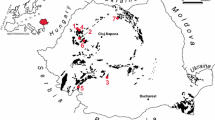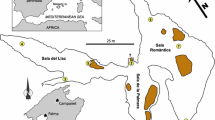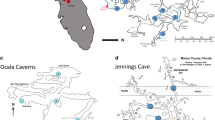Abstract
Bulgaria is a country in the eastern part of the Balkan Peninsula, in South-eastern Europe. The presence of many mountains and karst areas is a prerequisite for a large number of caves in the country, but only some of them are managed and accessible to tourists. The purpose of the study is continuous measurement of radon concentration in six popular Bulgarian tourist caves (Bacho Kiro, Magura, Venetsa, Saeva dupka, Snejanka, and Uhlovica), and analysis of the diurnal variation. The direct, continuous radon measurements were performed with TERA (TSR4) system (Tesla, Czech Republic). 29 radon concentration time series were considered for evaluation of radon variations during the day and night. The period of the measurement was the autumn of 2019, and only one cave (Bacho Kiro Cave) was measured during the winter. The measurements were performed at different points (gallery, halls, or other cave formations) in each of the caves. The average diurnal radon concentration in the different caves varied from 531 Bq m−3 (Magura cave) to 5472 Bq m−3 (Venetsa cave). The variation of radon concentration between distinct places in most caves was approximately 1–2 k Bq m−3. No significant difference in radon concentrations was observed between night and day in a 24–96 h period measurement. The large fluctuations between the values measured at the entry (10–640 Bq m−3) and exit (165–927 Bq m−3) compared to those inside the cave were found only in cave Magura. The radon exposure of workers and visitors was assessed, using long-term measurements in the caves, based on the ICRP recommendation.



Similar content being viewed by others
Data availability
The datasets generated during and analyzed during the current study are available from the corresponding author on reasonable request. Data from passive measurements of radon concentration in caves are available at link https://www.sgem.org/index.php/elibrary-research-areas?view=publication&task=show&id=8340.
References
J. Hakl, I. Hunyadi, I. Csige, I. Csigea, G. Gécz, L. Lénárt, A. Várhegyi, Radon transport phenomena studied in Karst caves-international experiences on radon levels and exposures. Radiat. Meas. 28, 675–684 (1997). https://doi.org/10.1016/S1350-4487(97)00163-7
F. Bochicchio, G. Campos-Venuti, S. Piermattei, C. Nuccetelli et al., Annual average and seasonal variations of residential radon concentration for all the Italian Regions. Radiat. Meas. 40, 686–694 (2005). https://doi.org/10.1016/j.radmeas.2004.12.023
Dubois, G. An overview of radon survey in Europe. EC, Joint Research Center Report, Luxembourg (2005). /Downloads/EUR_RADON_2005_final.pdf
Z. Stojanovska, P. Bossew, S. Tokonami, Z.S. Zunic, F. Bochicchio, B. Boev, M. Ristova, J. Januseski, National survey of indoor thoron concentration in FYR of Macedonia (continental Europe–Balkan region). Radiat. Meas. 49, 57–66 (2013). https://doi.org/10.1016/j.radmeas.2012.11.023
M. Mullerova, K. Kozak, T. Kovacs, I. Smetanova, A. Csordas, D. Grzadziel, K. Holy, J. Mazur, A. Moravcsik, M. Neznal, M. Neznal, Indoor radon survey in Visegrad countries. Appl. Radiat. Isot. 110, 124–128 (2016). https://doi.org/10.1016/j.apradiso.2016.01.010
K. Ivanova, Z. Stojanovska, B. Kunovska, N. Chobanova, V. Badulin, A. Benderev, Analysis of the spatial variation of indoor radon concentrations (national survey in Bulgaria). ESPR (2019). https://doi.org/10.1007/s11356-019-04163-9
G. Cinelli, M. De Cort, T. Tollefsen (Eds.), European Atlas of Natural Radiation (Publication Office of the European Union, Luxembourg, 2020). https://remon.jrc.ec.europa.eu/About/Atlas-of-Natural-Radiation
S. Darby, D. Hill, A. Auvinen, J.M. Barros-Dios et al., Radon in homes and lung cancer risk: collaborative analysis of individual data from 13 European case-control studies. BMJ 330, 223–226 (2004). https://doi.org/10.1136/bmj.38308.477650.63
S. Darby, D. Hill, H. Deo, A. Auvinen et al., Residential radon and lung cancer: detailed results of a collaborative analysis of individual data on 7,148 subjects with lung cancer and 14,208 subjects without lung cancer from 13 epidemiological studies in Europe. Scand. J. Work Environ. Health. 32(S1), 1–84 (2006)
R.D. Daniels, M.K.I. Schubauer-Berigan, Radon in U.S. workplaces, a review. Radiat. Prot. Dosim. 176(3), 278–286 (2017). https://doi.org/10.1093/rpd/ncx007
A.E. Abd-Elmoniem, Assessment of environmental health risks due to indoor radon levels inside workplaces in Sudan. Int. J. Environ. Anal. Chem. (2021). https://doi.org/10.1080/03067319.2021.1873317
J. Lario, M.S. Sanchez, J.C. Canaveras, S. Cuezva, V. Soler, Radon continuous monitoring in Altamira Cave (northern Spain) to assess user’s annual effective dose. J. Environ. Radioact. 80, 161–174 (2005). https://doi.org/10.1016/j.jenvrad.2004.06.007
V. Radolić, I. Miklavčić, M. Poje, M. Varga, B. Vuković. Radon concentration in Đurovića cave (Čilipi, Croatia). Radon Environ. Pol. Acad. Sci. 1, 32–32 (2009) (CROSBI ID: 447998)
D. Paar, M. Ujević, D. Bakšić, D. Lacković, A. Čop, V. Radolić, Physical and chemical research in Velebita pit (Croatia). Acta Cardiol. 37(2–3), 273–278 (2008). https://doi.org/10.3986/ac.v37i2-3.151
J.T. Duffy, J.S. Madden, G.M. Mackin, A.T. McGarry, P.A. Colgan, A reconnaissance survey of radon in show caves in Ireland. Environ. Int. 22, 415–423 (1996). https://doi.org/10.1016/S0160-4120(96)00140-7
C. Dueas, M.C. Fernndez, Seasonal variations of radon and the radiation exposure levels in Nerja cave, Spain. Radiat. Meas. 46, 1181–1186 (2011). https://doi.org/10.1016/j.radmeas.2011.06.039
V. Radolić, I. Miklavčić, M. Poje, D. Stanić, B. Vuković, Radon levels in Manita Peć Cave (Croatian NP Paklenica) and assessment of effective dose received by visitors and tourist guides. IRPA 13 (Glasgow) (2012). https://doi.org/10.1088/0952-4746/32/1/E02
UNSCEAR, Sources and Effects of Ionizing Radiation. UNSCEAR 2000 Report to the General Assembly, with Scientific Annexes, vol. 1. (2000) https://www.unscear.org/docs/publications/2000/UNSCEAR_2000_Report_Vol.I.pdf
EC, European Commission, Council Directive 2013/59/EURATOM, laying down basic safety standards for protection against the dangers arising from exposure to ionizing radiation, and repealing, OJ of EU, L 13/1.T. 2013. (2014) https://eur-lex.europa.eu/LexUriServ/LexUriServ.do?uri=OJ:L:2014:013:0001:0073:EN:PDF
ICRP, Occupational intakes of radionuclides: part 3. ICRP publication 137, Ann. ICRP 46 (3/4), 2017. TG95 OIR3 report for publication (2017)
WHO, Handbook on indoor radon: a public health perspective. WHO press, Geneva, Switzerland (2009). https://www.who.int/publications/i/item/9789241547673
CM, Regulation on radiation protection, adopted by CM Decree № 20/14.02.2018, amended by CM No.455/22.12.2020. (2020) https://bnra.bg/en/document/naredbi/
Handbook, TSR4 WLAN wireless and USB radon probe technical specifications & operation manual, Tesla, v.1 (2017). https://www.tesla.cz/wp-content/uploads/2020/11/052-410-047-TSR4_probe_manual_en_v1.pdf
B. Kunovska, D. Djunakova, J. Djounova, K. Ivanova, Z. Stojanovska, Radon in tourist caves in Bulgaria, as air polluter and exposure control. SGEM 2021(21), 95–104 (2021). https://doi.org/10.5593/sgem2021V/4.2/s19.14
A. Onishchenko, M. Zhukovsky, The influence of uncertainties of radon exposure on the results of case-control epidemiological study. Int. J Radiat. Biol. 95, 354–359 (2019). https://doi.org/10.1080/09553002.2019.1547846
G.K. Gillmore, M. Sperrin, P. Phillips, A. Denman, Radon hazards. Geology and exposure of cave users: a case study and some theoretical perspectives. Ecotoxicol. Environ. Saf. 46, 279–288 (2000). https://doi.org/10.1006/eesa.2000.1922
M. Sperrin, T. Denman, P.S. Phillips, Estimating the dose from radon to recreational cave users in the Mendips, UK. J. Environ. Radioact. 49, 235–240 (2000). https://doi.org/10.1016/S0265-931X(99)00108-3
C. Pinza-Molina, J.M. Alcaide, R. Rodriguez-Bethencourt, J. Hernandez-Armas, Radon exposure in the caves of Tenerife (Canary Islands). Radiat. Prot. Dosim. 82, 219–224 (1999). https://doi.org/10.1093/oxfordjournals.rpd.a032628
M. Bahtijari, J. Vaupotič, A. Gregorič, P. Stegnar, I. Kobal, Exposure to radon in the Gadime Cave, Kosovo. J. Environ. Radioact. 99, 343–348 (2008). https://doi.org/10.1016/j.jenvrad.2007.08.003
Acknowledgements
The study is supported by the National Research Fund under contract №КП-06-23/1/17.12.2018. The team is very grateful to the administrative management of the caves and the tour guides.
Author information
Authors and Affiliations
Corresponding author
Rights and permissions
Springer Nature or its licensor (e.g. a society or other partner) holds exclusive rights to this article under a publishing agreement with the author(s) or other rightsholder(s); author self-archiving of the accepted manuscript version of this article is solely governed by the terms of such publishing agreement and applicable law.
About this article
Cite this article
Kunovska, B., Ivanova, K., Djunakova, D. et al. Continuous diurnal radon measurements in Bulgarian caves and dose assessment. Eur. Phys. J. Spec. Top. 232, 1617–1623 (2023). https://doi.org/10.1140/epjs/s11734-023-00874-w
Received:
Accepted:
Published:
Issue Date:
DOI: https://doi.org/10.1140/epjs/s11734-023-00874-w




